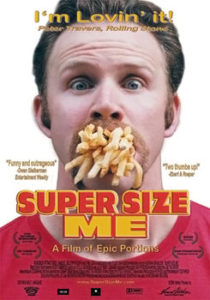- Mise-en-Scene and Visual Analysis.
The textbook explains mise-en-scene as every element in the frame that contributes to the overall look of the film. The author says that its quite literally everything “set design, costume, hair, make-up, color scheme, framing, composition, lighting… Basically, if you can see it, it contributes to the mise-en–scène.” (3). A good example that is used in the textbook are the films of Wes Anderson which are known to be kind of “every frame a painting” kind of films that are dripping in atmosphere and motif. You know when you are seeing a Wes Anderson film because of his intense detail in setting, lighting, color, and composition. Here is a fun little youtube video by GripUp about Mise-en-Scene (Understanding Mise-en-scene (Links to an external site.) )
)
Some typical and extreme elements of the mise-en-scene in Super Size Me are how Spurlock jams a lot his frames and sequences with the happy bright colors and characters associated with fast food chains like McDonalds. The locations are often in the fast-food restaurants with lots of bright red and yellow with bright lighting. He uses the food as a prop, we often see him holding up the sickly-looking big macs, chicken tenders, French fries, and sodas. The staging is specifically done to make sure that they are in the frame and in a lot of the frames we will see the cardboard cutouts of characters like Ronald McDonals, the Hamburgler, Grimace, and the like. These bright caricatures are often juxtaposed with him sitting down after the meal in the back of a car or a dimly lit apartment with him looking absolutely sick to his stomach.
The author speaks about how a character can inabit a performance and how we as the audience can “examine the physical dsign” of performance or character. While Super Size Me is a documentary I think that Spurlock does exaggerate his performance to get a desired effect. He plays into the happiness and ecstasy of eating the fast food and then will also play into how much he is suffering after eating it. Not to say that he wasn’t actually feeling all of these things but rather he just makes those emotions a bit bigger so that we can feel it through the screen. I think of the scene where he acts like a grade school child eating his big mac only to vomit it all up in the parking lot just a few minutes later. He is undoubtedly the star performer of the film but I also think that the doctors he goes to see also exaggerate their performances. I think of the Saudi endocrinologist who tells him hes going to die if he continues his experimental diet and I think he too was playing up his character a bit.
The cinematography of the film is fairly typical. We do see a lot of narrow shots that focus on Spurlock and his ecstasy or discomfort. We also get lots of longshots of him sitting alone after the McBinges showing how isolating and lonely he’s feeling while he’s in pain. The cinematography relates to the documentary genre in that it feels pretty low budget but candid so that we really feel like we are watching this honest transformation of a man letting his health slide to prove a point. I remember watching an Italian docudrama profiling a heroin addiction and Super Size Me reminds me of that quite a bit.
- Special Effects
I do not believe that there were any special effects used in the documentary, at least not to my knowledge.
- Functions
I think that the function here is to profile the destructive capability of regular fast-food consumption. The film really shows in excruciating detail just how adverse the physiological and psychological effects of this food really are.

